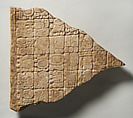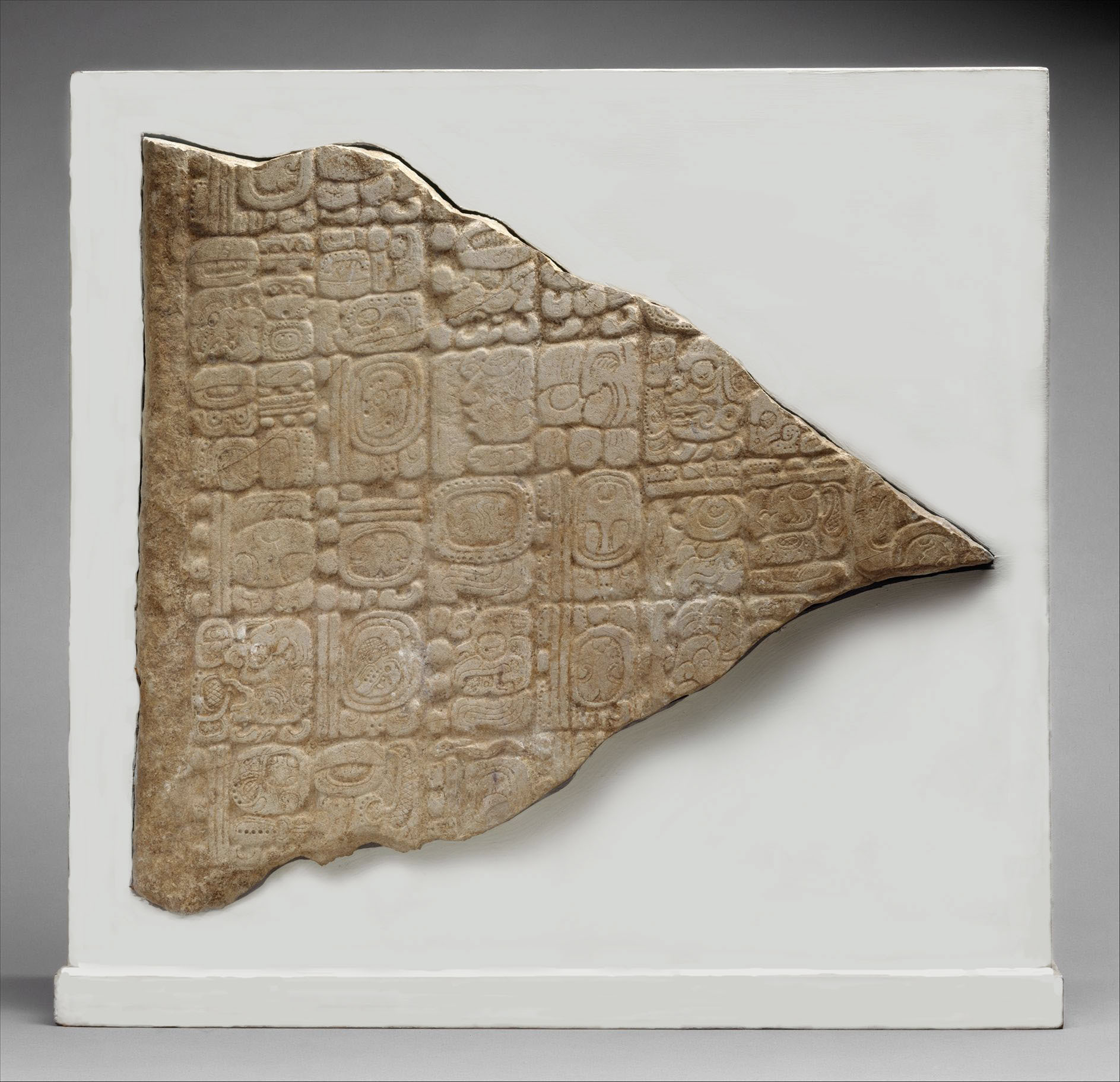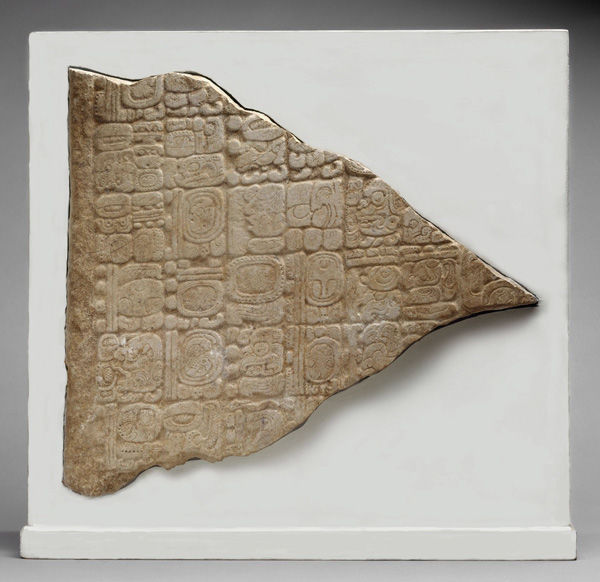Stela Fragment with Glyphs
Not on view
This is a fragment of the bas relief known as Tortuguero Monument 6, which contains one of the most infamous and contentious hieroglyphic texts in the Classic Maya (ca. a.d. 250–900) corpus. For many years epigraphers and lay enthusiasts honed in on the final passage of the text as a "prophecy," a tale of what would have happened on the date 13.0.0.0.0 4 Ahaw 3 K'ank'in in the Maya calendar. This corresponded to a day in December 2012, leading to spurious and sensational claims about an end of days predicted by the ancient Maya. The Met's fragment contains a pivotal portion of the text.
The main event of the Tortuguero Monument 6 text is the ritual dedication of a building, quite possibly a mortuary structure, on the date January 11, a.d. 669 (9.11.16.8.18 9 Etz'nab 6 K'ayab). A local lord of Tortuguero, calling himself "Lord Jaguar," burned fire for the first time in the structure on that date, activating it as a ritual space. Throughout the text, the sculptor makes reference to future and past calendric period endings, similar to saying something like "just before the New Year," or "after last Fourth of July." Scribes did this to anchor these mortal events in the giant cosmic cycles recorded in both the Long Count (a linear calendar counting up from a fixed point in 3114 b.c.) and the Calendar Round (an interlocking set of coefficients, months, and days that cycled completely every fifty-two years).
The local history of Tortuguero is intimately linked with that of the great Classic Maya kingdom of Palenque, in modern-day Chiapas, Mexico. In fact, rulers at Tortuguero, in the nearby state of modern-day Tabasco, used the same emblem glyph as Palenque, part of a sort of dynastic heraldic symbol or toponym. Scholars know little about the origins of the dynasty at Tortuguero: Was the lineage using the same emblem glyph because they were subordinate to the dynasts at Palenque, or were the rulers at Tortuguero members of a rival faction that splintered from the Palenque patrilineal sequence? The modest site's unfortunate destruction in the mid-twentieth century make future archaeological and epigraphic work challenging.
Returning to the entire text of Monument 6, it is read in two columns from left to right and then up to down. The Met's fragment begins with a distance number that projects the narrative forward in time: "One hundred sixteen days later he was seated, then he descended (or arose); it was his first, his flint and shield (and) lances were joined at Ayiin, then Xam, he of Uux Te'K'uh suffered a "star war"; it was on the day 13 Kimi 14 Sek (9.10.11.9.6) [a.d. 644]. Ninety-two days later, on 10 Ok 18 K'ayab (9.10.12.3.10) [a.d. 645], then it was chopped ..." This passage is a common construction in late Classic Maya texts in which kings list off conquests in the commemoration of an anniversary or dedication of a shrine, such as this case.
The middle two columns of the Met's fragment begin with another distance number and the recording of an accession of someone into rulership in December a.d. 647, or the day 11 Chuwen 4 Muwaan (9.10.15.1.11), using the metaphors "seating into rulership" and "tying/binding the word." The following distance number projects back in time to remind the reader that thirty-one days prior to the seating of the ruler was an important calendric checkpoint, 9.10.15.0.0., occurring on the day 6 Ajaw, 13 Mak (November a.d. 647).
The third pair of columns preserved on the Met's fragment record something that happened on the date 9.11.15.0.0 (a.d. 667), twenty years after the anniversary mentioned on the preceding columns. The brief text commemorates the dedication of a building called the "Six-Stone House of Six Cached Hammer Celts." The agent of this dedication, Bahlam Ajaw, the Holy Lord of Tortuguero, is mentioned on the following part of the text from another fragment. The building is likely the one that held this monument recording its dedication.
The monument's text conveys several metaphors for violence found in Classic Maya inscriptions. The "star war" verb has received a lot of scholarly attention for its purported relationship to cycles of the appearance of Venus in the sky—in other words, that these "war" events were scheduled around astronomical phenomenon. However, the precise meaning of the hieroglyph of the star-spilling liquid over an emblem glyph remains elusive. Regardless, these "star war" events usually end up in a starkly negative political situation, as evidenced by a hiatus in building programs or monument dedications, for the named royal court on the receiving end.
Equally gruesome are two phrases on the largest fragment of Tortuguero Monument 6 describing the pooling of blood and piling up of skulls. Through the metaphor employed in this poetic couplet, the sculptor allows the reader to visualize the violence and carnage that resulted in lakes of blood and mountains of bones. However, it is quite possible that Lord Jaguar had his sculptors amp up the rhetoric on his past conquests in order to enhance his own prestige in the shadow of the more powerful lords of Palenque.
-----
Resources and Additional Reading
Arellano Hernández, Alfonso. Tortuguero: una historia rescatada. Mexico City: Universidad Nacional Autónoma de México, 2006.
Doyle, James. http://www.metmuseum.org/about-the-museum/now-at-the-met/2015/tortuguero
Graham, Ian. The Art of Maya Hieroglyphic Writing. Cambridge: Peabody Museum Press, 1971.
Gronemeyer, Sven. "The Maya Site of Tortuguero, Tabasco, Mexico: Its History and Inscriptions." Acta Mesoamericana 17 (2006). Markt Schwaben: Verlag Anton Saurwein.
Gronemeyer, Sven, and Barbara MacLeod. "What Could Happen in 2012: A Re-Analysis of the 13-Bak'tun Prophecy on Tortuguero Monument 6." Wayeb Notes 34 (2010).
Houston, Stephen. "What Will Not Happen in 2012." Published on Maya Decipherment, December 20, 2008.
Martin, Simon. "Tikal's 'Star War' Against Naranjo." In Eighth Palenque Round Table, 1993, edited by Martha J. Macri and Jan McHargue. San Francisco: Pre-Columbian Art Research Institute, 1996.
Riese, Berthold. "La inscripción del Monumento 6 de Tortuguero." In Estudios de Cultura Maya 9 (1978): 191–5.
Stuart, David. "More on Tortuguero's Monument 6 and the Prophecy That Wasn't." Published on Maya Decipherment, October 4, 2011.
———. The Order of Days: The Maya World and the Truth About 2012. New York: Harmony Books, 2011.
Thompson, J. Eric S. A Catalogue of Maya Hieroglyphs, 438. Norman: University of Oklahoma Press, 1962.
Zender, Marc, and Stanley Guenter. "Three Kings of Late Classic Tortuguero." In Pre-Columbian Art Research Institute Newsletter 31 (2000): 6–8.
-----
James Doyle, 2015
Due to rights restrictions, this image cannot be enlarged, viewed at full screen, or downloaded.
This artwork is meant to be viewed from right to left. Scroll left to view more.





